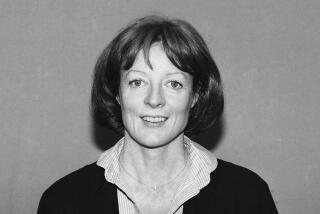More magic than tragic
- Share via
Red hair, ivory skin, slender, supple limbs and a light but forceful attack: Moira Shearer left an afterimage like nobody else in world ballet. In the tragic finale of “The Red Shoes” -- the 1948 film that made her an international star as the brilliant, suicidal ballerina Victoria Page -- it’s easy to summon up her luminous persona in the empty spotlight that we see retracing the path of her choreography.
No, Victoria Page will not dance tonight, and nobody will replace her, for Shearer died on Tuesday in Oxford, England, some two weeks after her 80th birthday. She took off the red shoes more than half a century ago, however, utterly disproving the film’s melodramatic notion that you can’t be a great ballerina without sacrificing everything else in life -- especially true love.
Other classical dancers may have chosen problematic offstage partners who drastically shortened their careers (Gelsey Kirkland), unnaturally prolonged them (Margot Fonteyn) or caused them to swerve off track (Suzanne Farrell). But Shearer had a happy 55-year marriage to author and broadcaster Ludovic Kennedy, and he was with her when she died -- in a hospital, not like Victoria Page under the wheels of a train.
Shearer came to an untimely end in more than one film besides “The Red Shoes,” dancing herself to death a la Giselle in “The Story of Three Loves” (1953) and into a murderer’s clutches a la “La Bayadere” in “Peeping Tom” (1960). And maybe we wanted to see her crushed in role after role as the price for all the talent and beauty she possessed. But away from the cameras, her greatest threat may well have been Ninette de Valois, founding director of England’s Royal Ballet.
The recent biography “Margot Fonteyn,” by Meredith Daneman, reveals how often De Valois ruthlessly sabotaged the talented women on her company’s roster to keep Fonteyn on top. For the company’s now-historic New York debut in 1949, De Valois sent Shearer onstage in “The Sleeping Beauty” in a new role and costume without the stage rehearsal she’d been promised -- and, back in London, the coach whom Shearer had sought out for “Giselle” was taken away from her and given exclusively to Fonteyn.
But, as they say, Shearer had her innings. Frederick Ashton choreographed his first full-length ballet, “Cinderella,” for her in 1948, and two years later, George Balanchine chose her over Fonteyn when he mounted his “Ballet Imperial” on De Valois’ company. She later wrote about the experience with great verve and insight.
Hollywood sources say that Fred Astaire wanted Shearer for “Royal Wedding” and that Gene Kelly wanted her for “Brigadoon,” but acting in Shakespeare and Shaw called to her more strongly.
Shearer collectors should seek out RCA Victor LM 6115, a vintage three-LP set containing a complete 1954 Old Vic performance of “A Midsummer Night’s Dream,” with Shearer remarkably authoritative as Titania opposite Robert Helpmann (Oberon), Stanley Holloway (Bottom) and such Shakespearean specialists as Anthony Nicholls, Margaret Courtenay and Patrick Macnee.
Recently, OpusArte released on DVD Gillian Lynne’s 1987 dance-drama “A Simple Man,” in which Shearer danced with England’s Northern Ballet Theatre at age 61: maternal, of course, but still luminous, lighted from within. (The video is available from Naxos of America.)
Her films make her an emblem of madness and death: the fatally obsessive broken blossom of ballet. But those who sampled the full range of her artistry won’t forget the way she could make every step or speech or moment of stillness shine for all to see.
This was one dancer and actress who found no conflict between life and art: She brought to both the same consummate intelligence and grace.
More to Read
The biggest entertainment stories
Get our big stories about Hollywood, film, television, music, arts, culture and more right in your inbox as soon as they publish.
You may occasionally receive promotional content from the Los Angeles Times.










